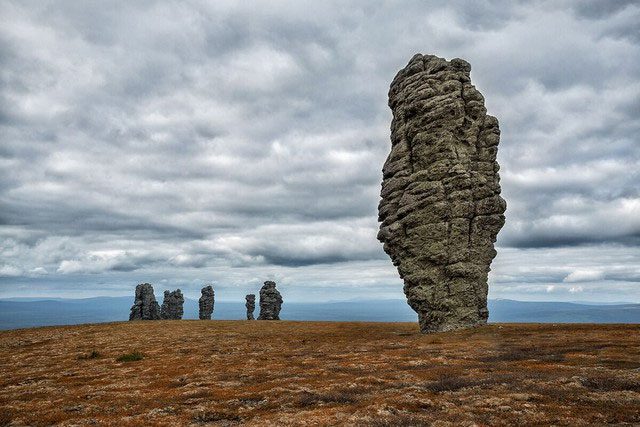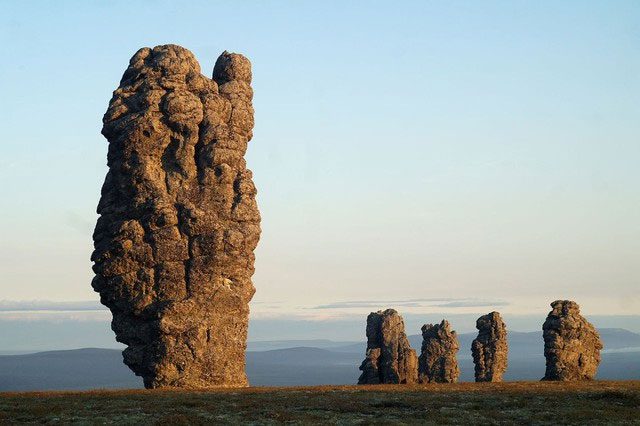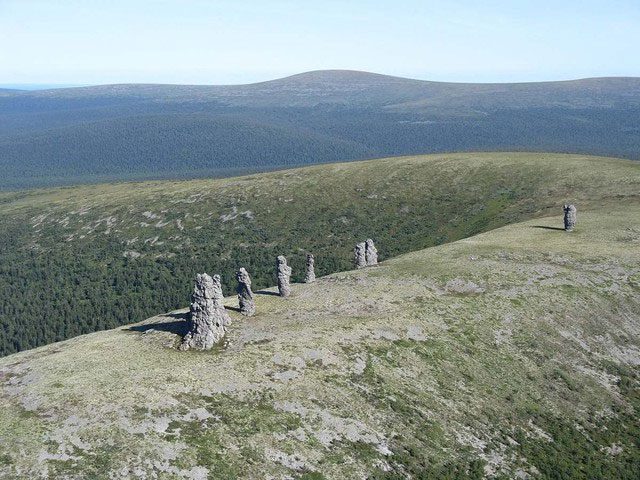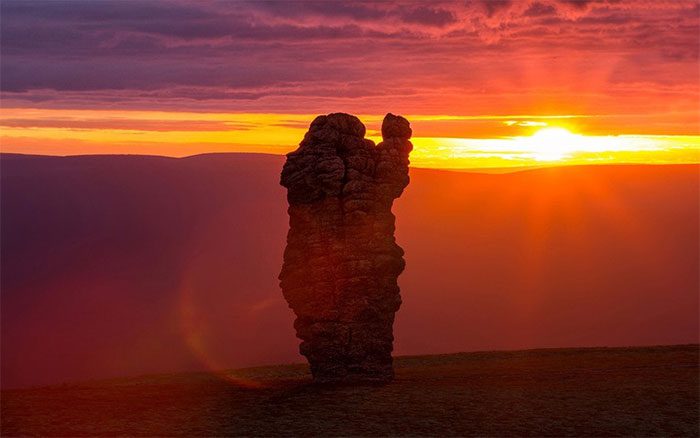Deep within the wild expanse of the Komi Republic in Russia, seven gigantic stone pillars, known as Manpupuner, rise majestically amidst the Ural Mountains. Nicknamed the “Seven Giants,” these geological formations have long captivated the curiosity of geologists, mountaineers, and local residents. But what makes these stone pillars so special and mysterious?
Approximately 200 million years ago, the Manpupuner area was once home to towering mountain peaks. However, over millions of years, the harshness of nature—from rain, snow, wind, to frost—relentlessly eroded and dismantled these mountain ranges. Ultimately, only the hardest rock layers remained, forming the solid pillars we see today.
The Manpupuner pillars, standing between 98 to 138 feet (30-42 meters) tall, create a stunning spectacle in the wilderness. The main component of these stone pillars is quartz-sericite schist, a type of rock that withstands weathering better than the surrounding rocks. This property has allowed them to endure after millions of years of natural erosion.

Manpupuner, also known as “The Seven Giants,” is one of the most unique and mysterious natural wonders in Russia. Located on the western plateau of the Ural Mountains, these gigantic stone pillars have captured the interest of scientists and travelers from around the globe.
Although scientists have provided explanations for the geological formation, the local Mansi people have a different, mythological story. According to legend, these stone pillars were once a group of Samoyed giants on their way to invade the Mansi tribe. However, upon seeing the sacred mountains of the Mansi, their leader dropped his drum. Immediately, the entire group was turned to stone, becoming the pillars that stand still amidst the Ural Mountains.
This oral tradition not only adds to the mystique of Manpupuner but also creates a blend of nature and indigenous culture, making every visitor feel as if they are confronting a surreal world.

Before science offered explanations, the local residents crafted colorful mythological stories to explain the appearance of these stone pillars. One legend tells of giants who were turned to stone after a battle with the Mansi tribe. Another version recounts a shaman who turned the giant warriors to stone to protect the land, along with many other varying tales.
With its extraordinary beauty and geological significance, in 2014, Manpupuner was officially recognized as one of the seven natural wonders of Russia. This title further confirms the uniqueness of the stone pillars, as there are no similar formations anywhere else in the world.
Manpupuner is not only a collection of giant stones nestled in the mountains but also a symbol of the perfect blend of nature, time, and resilience. The surrounding landscape is equally majestic, with valleys, lakes, and mountains creating a captivating natural tableau.

From a scientific perspective, the formation of Manpupuner’s rocks is the result of millions of years of natural weathering.
These stone pillars were originally part of a high mountain range. Over time, due to the effects of rain, wind, frost, and temperature fluctuations, the softer rock layers were gradually eroded. Eventually, only the sturdy pillars primarily composed of quartz remained, forming the unique shapes we see today.
Despite their fame, accessing Manpupuner is not an easy task. The stone pillars are located in an extremely remote area, at least 100 km away from the nearest train stations or highways. This is a challenging journey that only the most determined travelers dare to undertake.
For those who prefer not to endure a strenuous trek, a helicopter ride is the easiest way to reach the area. However, for adventure enthusiasts wanting to fully experience the pristine beauty of Komi, a long hike through the forests and mountains is an unmissable option.
The ideal time to visit Manpupuner depends on individual tolerance to harsh weather. Summer, particularly August, offers mild weather and fewer mosquitoes. In contrast, winter transforms the area into a frozen wonderland, with the stone pillars covered in snow, presenting an equally magnificent sight.


Despite its fame, accessing Manpupuner is not an easy task.
Manpupuner impresses not only with its natural beauty but also with the sense of mystery it evokes. Many visitors describe feeling an inexplicable fear when standing before these colossal stone pillars. Perhaps it’s due to their grandeur, the absolute isolation of the area, or something intangible that we cannot identify.
Whatever the reason, the Manpupuner pillars remain a natural wonder worth admiring. With a blend of millions of years of geological history and vibrant cultural legends, it is undoubtedly a destination that everyone should visit at least once in their lifetime.


















































